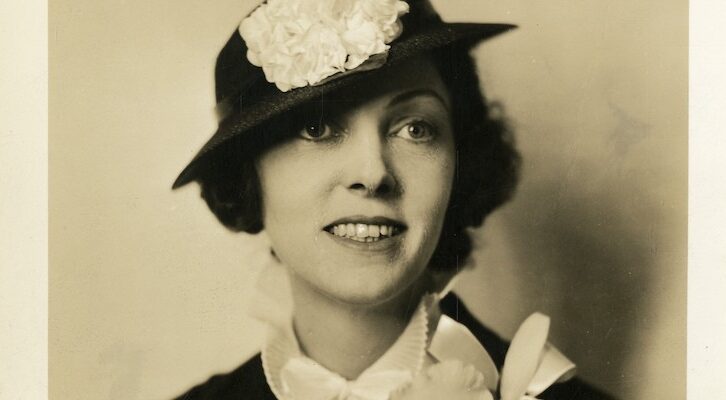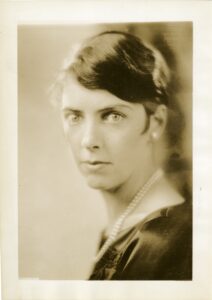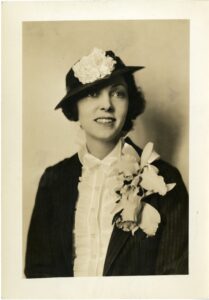
The Female Journalist Who Helped Create the Field of Science Reporting
Marcel Chotkowski LaFollette on Jane Stafford, Gender in Journalism, and the Pioneering Science Service Organization
For mid-twentieth-century female journalists, especially ones who covered science and medicine, gender-based bias and restrictions were commonplace. To their credit and to the benefit of millions of readers, a group of accomplished women at a small Washington, DC-based science news organization—the Science Service—overcame such barriers and, with self-confidence, intelligence, and skill, pioneered in the nascent field of science journalism.
Jane Stafford, the first full-time medical journalist at Science Service, never conformed to any popular stereotype—neither the adventurous “Nelly Bly” nor Rosalind Russell’s fast-talking “Hildy Johnson” in Our Girl Friday. Colleagues in the news business described Stafford as a “beautiful wild flower,” graceful, well-mannered, skilled at “sophisticated” conversation, and infallibly professional.
Stafford enjoyed stylish suits, hats, and pearls, and her personal letters expressed familiar concerns such as what to do with her “abundant and fairly long locks.” “I think a scissors is indicated,” she wrote, and perhaps she would “try a few spring bonnets on first, and see whether or not they demand hair or will let me be comfortable again.”
For Stafford, however, bonnets served as convenient window dressing. She was serious and tough. Her attention focused on the latest research announcements not department store fashions. She knew how to navigate the whitewater of medical politics, shrug off unfair criticism, weather controversy, and get back to reporting. Hired in May 1928, Stafford remained at Science Service until 1956.
Stafford became a journalist at a pivotal moment for the medical research enterprise in the United States and she was celebrated in the Journal of the American Association of University Women as one of Slosson’s new “middlemen of science.” She brought two essential elements to that role: training that allowed her to assess and comprehend efficiently the voluminous journal literature, and the strength of character to stand her ground in the midst of controversy.
A desk piled high with medical reports and news releases meant nothing if a writer could not distinguish the significant research from the routine (or the questionable). In Chicago, Stafford had worked among the powerful men controlling the AMA and its publications, and learned about the medical information system, its reliance on peer review, and its terminology and standards.
To their credit and to the benefit of millions of readers, a group of accomplished women at a small Washington, DC-based science news organization—the Science Service—overcame such barriers and, with self-confidence, intelligence, and skill, pioneered in the nascent field of science journalism.
Her correspondence, especially with physicians, revealed familiarity with a wide range of topics and a willingness to turn on the charm, as necessary, with hesitant sources. In the end, though, she gained respect through diligence and hard work, attending dozens of conferences and seminars every year, interviewing researchers, poring over technical material to stay informed on background, and then skillfully translating research results into readable prose.
Within months of joining the Science Service staff, Stafford began exploring controversial topics. In late August 1928, she wrote about a brand of tobacco supposedly rendered free of nicotine, basing one article titled “‘Denicotined’ Tobacco Declared a Fraud” on an item in the latest issue of JAMA. When Herbert Sackett, president of the Bonded Tobacco Company, complained to the New York World (which had reprinted Stafford’s article), the newspaper asked for an explanation. Stafford, confident of her sources and in a rapid response typical of how she faced criticism, quickly supplied evidence and background without defensiveness.
 Jane Stafford (1899–1991), ca. 1928. Courtesy of the Smithsonian Institution Archives
Jane Stafford (1899–1991), ca. 1928. Courtesy of the Smithsonian Institution Archives
Dinner table advice from a brother in medical school must have been useful in learning how to cope with unfair criticism and pigheaded researchers. In a notable instance early in her career, a complaint had come from a senior scientist at her brother’s school. James Angus Doull, head of a major project on the common cold, complained to Slosson that he had received a telephone call from a Baltimore Sun reporter who had a statement “written by Science Service” that “purported to be an account of findings announced by me on the evening of February 11, 1929, before the Johns Hopkins University Medical Society.”
Doull asserted that he alone possessed the intellectual rights to any descriptions of his research, even if shared in an open meeting.
I was unaware that any report of this meeting had been made or that any reporters had been present, for although no effort is made to inquire into the identity of visitors, the Society is strictly a professional one. That a report should have been made by your service and without giving me an opportunity to read it before publication, astonished me. [N]either Science Service nor any other publicity agency has any right to this material without my consent prior to publication in scientific journals. The publication of material without permission, particularly when it contains errors, render your publicity bureau subject to very serious criticism, and it is very embarrassing to us.
When he wrote that letter, Doull had already spoken on the phone to Watson Davis, who had explained that the story had already been distributed but the news service would issue a correction if Doull identified any errors. Doull demurred, refusing to give corrections “over the telephone without any time for reflection.” In a follow-up letter, Davis explained,
We do in many cases submit reports to investigators before publication, particularly when there is any doubt in the mind of the writer as to the accuracy of the report. But your presentation before the Medical Society was so clear and lucid, your data was so carefully prepared in writing upon the blackboard of the meeting, that we had no doubt as to the validity of our report.
Stafford had, in fact, written to Doull before the presentation, asking for additional information, but one of Doull’s assistants had told Stafford “that the only way to obtain the material would be to attend the meeting.” Davis challenged Doull’s objection to the “presence of reporters at Medical Society meetings” because journalists had always been “welcome” at these in the past and “worked very closely” with the major medical societies.
Stafford had also attempted to obtain information about the project when it was first announced but had been informed that “the work had not progressed far enough to justify the announcement of results.” Such tedious, time-consuming exchanges with researchers, negotiating the terms of when the public might be informed, were commonplace for all medical and science journalists. Like her colleagues, Stafford learned how to maintain good relationships with the communities she covered, listening patiently to complaints but standing up to unfair or unreasonable criticism.
When Stafford became entangled in one amusing (if annoying) example of such absurdity, she acted swiftly and with characteristic pragmatism. To route the volume of paper documents in the office and track responsibility for action (e.g., who wrote, edited, accepted, or rejected a manuscript), Slosson and Davis had instituted a coding system based on staff members’ initials. Stafford had been hired as the writer responsible for medical material, but her new colleague James Stokley already used the initials “JS,” so Stafford inherited her predecessor’s code designation (MD, for MacDill).
Many years later, the notoriously acerbic Science Service trustee James KcKeen Cattell suddenly noticed the initials on an internal document and accused Stafford of pretending to be a medical doctor (an MD). Rather than reacting with anger, Stafford simply changed her office code to “St.” By refusing to engage in a stupid skirmish, she won the war.
Over the years, Stafford’s reporting spanned the breadth of medicine and public health, from blood transfusions to schizophrenia, influenza to rat-borne diseases, tuberculosis to toothaches. She wrote hundreds of articles about cancer rates, detection, treatment, and “cures.” During the Depression, she explored the connection between food and nutrition; when the world engaged in war, she wrote about health on the home front, “victory meals,” meat substitutes, and how European snowstorms might affect soldiers’ health.
Over the years, Stafford’s reporting spanned the breadth of medicine and public health, from blood transfusions to schizophrenia, influenza to rat-borne diseases, tuberculosis to toothaches.
She documented the “war on polio” in 1943, prevention and treatment of venereal disease during World War II, and after 1945, the physiological effects of atomic radiation. During the 1950s, she described research to create “spare parts” for human bodies and new techniques for transplanting corneas.
To enliven her writing, Stafford frequently drew on literary and cultural themes, such as in one of her first bylined articles: “Ancient Greek heroes, both legendary and actual, Egyptian soldiers of the time of Ramses II, Assyrians who lived in the biblical city of Nineveh, Greek and Roman bathing beauties of the earliest times and even Venus herself all used a swimming stroke almost identical with the over-hand stroke popular today.”
She would also add wry humor to serious discussions of health advice. “Men no longer expect to find a miraculous Fountain of Youth,” but if they want to “live out their allotted three score and ten years,” she wrote in 1930, “the secret of a long healthy life is not to be found in a particular brand of cigar.” Her article topics in the 1930s ranged from radiation therapy (“Fighting Cancer with Newest Weapons”) to alcoholism (“What Intoxication Does to Your Nerves”). She practiced journalism with heart as well as mind, often commenting on how medicine and society must work together to distribute health benefits equitably.
Stafford also demonstrated an exceptional ability to identify emerging “hot topics.” Within six months of being hired, she wrote “What Plague Will Follow the Next War?” which described public health experts’ “cold-blooded, conservative estimates” about the impacts of another world war (“A new plague of germs, made more deadly by evolution’s transmutation. An epidemic of insanity, like shell shock, conquering the civilian population. An epidemic of vitamin hunger. A new disease of nutrition that will fell thousands. A pestilence of the air, brought by winging planes”), and in 1929, she anticipated modern epidemiological threats (“Dangerous stowaways may ride on the great aircraft that link continents together. Invisible creatures that would add not an ounce to an airship’s weight can hide where the cleverest officer could not find them. Disease germs lurking in the bodies of passengers or crew”).
Like many of her colleagues, Stafford had not set out to become a science writer, observing that “my own training was not taken with the idea of fitting me for my present position.” She advised young people interested in such a job to study science “as thoroughly as possible” because “the tricks of journalism…can be picked up quickly by a person with natural ability for writing,” whereas a science education brought deeper understanding of research, investigation, and analysis. Appreciation for the science, she argued, was like the difference “between one who knows music only through hearing it and one who has learned to perform, however badly or little, on some musical instrument.”
Not every reporting assignment included sweet music, of course. Science journalists could be caught between warring academic factions, or used in attempts to trigger publicity and claim credit. Stafford once found herself enlisted in a battle to help correct the record and refute a false claim. In 1932, she had written about the use of methylene blue to treat cyanide poisoning, and soon afterward, pharmaceutical executive Clifford S. Leonard complained that the article had not mentioned “the person who conceived the idea.”
Leonard’s letter was polite, detailed, and insistent. Neither the scientist credited in Stafford’s article “nor anyone else,” he argued, had had “any idea of using it as a systematic antidote” until Matilda Moldenhauer Brooks had applied it in the laboratory and published her results in two well-respected journals. Although Matilda had a PhD from Harvard University and had worked for the US Public Health Service before joining the University of California research staff, Leonard could not help giving her additional “authority” by identifying her as the wife of University of California zoology professor Sumner C. Brooks.
An article in a San Francisco newspaper had eventually given Matilda due credit, so Leonard admitted that if Stafford had gotten the information earlier, from one of the other scientists involved in the dispute, then the omission was not her fault. “Between you and me,” Leonard remarked, “there is a pretty general opinion of the ability of that [other] scientist to acquire credit whether deserved or not.” He mentioned that Matilda had newer results that she would be publishing “shortly,” and suggested Stafford write about those findings and “give her credit in that way.”
Stafford immediately responded with thanks, noting that the article had indeed been based on the other scientist’s JAMA report: “The importance of Mrs. Brooks’ work was not made clear in this [ journal article] but has already been called to our attention. We are awaiting the outcome of correspondence with her before issuing a second story.” Within less than a month, Stafford had written a follow-up piece, crediting Matilda with the methylene blue discovery. “I think it covers the ground satisfactorily,” Stafford told Leonard, “and I have tried tactfully to distribute the credit so as to show who did what first, etc.”
Correcting such misattributions of credit took time, especially when other journalists had written up the false claims and the error was being “repeated again and again.” The entire process of securing credit could be particularly frustrating for nonacademic female scientists and was only partially remediable through publicity. “The reason why I feel that these things ought to be clearly stated,” Matilda Brooks explained, “is that it is so absolutely characteristic of the whole medical profession to neglect completely the rich contributions of non-medical scientists upon which they build the structure of their own glorification. Such an attitude is socially bad not only for Science but for the medical profession as well.”
Stafford’s follow-up article also illustrated the cultural contexts in which both women worked. The news article byline was, per internal practice, to the news service, not Stafford individually; the article’s opening paragraphs identified Brooks as “Mrs.” and the other (male) scientist as “Dr.,” even though the text later stated that she “holds a doctor’s degree.” On the positive side, the illustrations included a photograph of Brooks and a drawing of a (generic) female scientist.
 Jane Stafford (1899–1991), 1930s. Courtesy of the Smithsonian Institution Archives
Jane Stafford (1899–1991), 1930s. Courtesy of the Smithsonian Institution Archives
Publicity could work in two ways. Even accomplished scientists withheld information until the last moment in order to maximize press attention. Stafford and many of her colleagues routinely engaged in reasonable embargo negotiations and would refrain from describing results in a news report until a researcher had first presented her work at a scientific meeting. Such cooperation depended upon receiving an advance copy, however. Waiting to listen to a presentation before writing it up and wiring a summary back to the office wasted valuable hours for reporters striving for timeliness.
With resolve, ingenuity, and self-confidence, Stafford chose the most efficient and professional paths to informing her readers and built a reputation for doing that well, with a smile and occasional tip of the bonnet.
In 1934, acting on a tip about a forthcoming announcement, Stafford had asked a researcher “when it would be agreeable” to interview him, but received a telegram only the night before his talk inviting “Science Service” to send a representative to the meeting in New Orleans. When both the researcher and medical society’s publicity chair refused to distribute prepared press releases until after the presentation, the enterprising Stafford wrote a story based on the abstract and information supplied by two other experts, and attempted (unsuccessfully) to get the publicity chair to approve the text.
As a last resort, she dispatched a freelance stringer to the meeting, combined his notes with her own background research, and wrote a story for publication. She tried again to persuade the scientist to meet and review her article, and again he refused, so she published it without interviewing him. Stafford later heard that the man was “opposed on principle to popularizing science” and had told others that he had “heard from ‘that girl from Science Service.'”
By then the thirty-five-year-old journalist had learned to ignore such misogynistic characterizations. With resolve, ingenuity, and self-confidence, Stafford chose the most efficient and professional paths to informing her readers and built a reputation for doing that well, with a smile and occasional tip of the bonnet.
______________________________

Adapted from Writing for Their Lives: America’s Pioneering Female Science Journalists by Marcel Chotkowski LaFollette. Reprinted with Permission from The MIT Press. Copyright 2023.
Marcel Chotkowski LaFollette
Marcel Chotkowski LaFollette is an independent historian and Research Associate at the Smithsonian Institution Archives. Marcel has taught at the Johns Hopkins University, the George Washington University, and the Massachusetts Institute of Technology. She is the author of several books, including Science on the Air and Science on American Television, Making Science Our Own: Public Images of Science, 1910–1955 and Reframing Scopes: Journalists, Scientists, and Lost Photographs from the Trial of the Century.



















